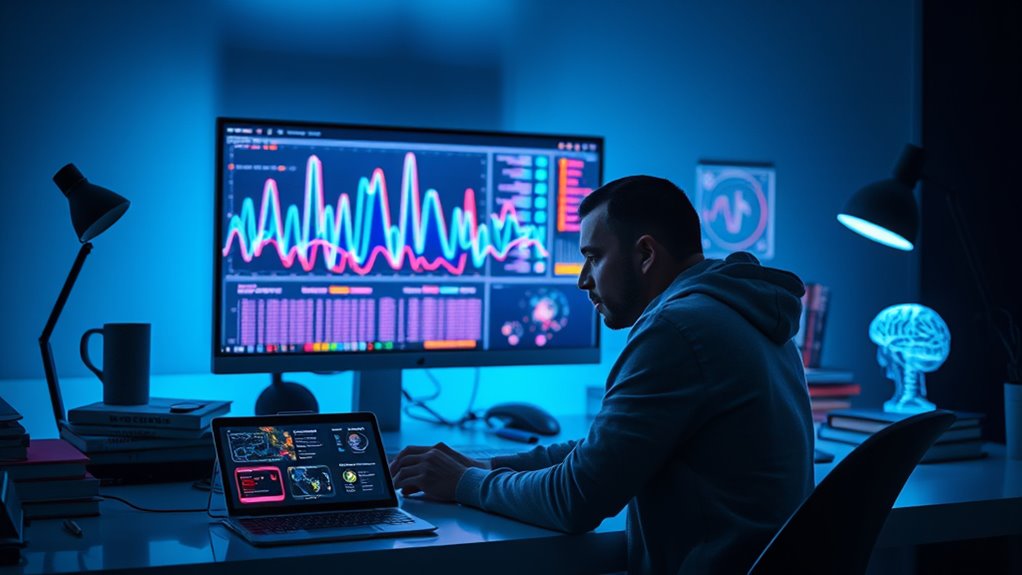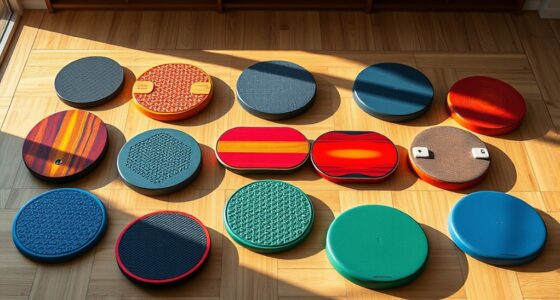If you’re looking to boost your brain power in 2025, I recommend exploring top neuroplasticity programs backed by neuroscience. These include cognitive exercises, mindfulness, physical activities, and structured workbooks like *Build a Better Brain* and *Retrain Your Brain.* They focus on rewiring neural pathways, improving memory, focus, and resilience. Many incorporate technology and progress tracking, making brain training effective and engaging. Keep going to discover how these powerful approaches can transform your mind and well-being.
Key Takeaways
- Top programs are evidence-based, utilizing proven neuroplasticity techniques like mental exercises, physical activity, and environmental stimuli.
- Many programs incorporate self-assessment tools, progress tracking, and personalized strategies for optimal brain remodeling.
- Leading options target diverse goals such as memory, focus, emotional resilience, and cognitive flexibility across different age groups.
- Programs like *Neuroplasticity (MIT Press)* and *Keep Sharp* emphasize lifelong mental growth and resilience in 2025.
- User engagement is enhanced through interactive, playful activities suitable for children, adults, and seniors, supporting sustained brain health.
The Brain’s Way of Healing Book

If you’re interested in understanding how the brain can heal itself naturally, *The Brain’s Way of Healing* is an essential read. Norman Doidge’s book explores neuroplasticity—the brain’s remarkable ability to rewire and recover through activity and experience. It challenges the outdated idea that brain damage is permanent, revealing how environmental energy like light, sound, and vibration can stimulate healing. The book shares inspiring stories of recovery from strokes, injuries, and neurological conditions. It shows that the brain’s complexity is a powerful asset in healing, offering hope and practical strategies for improving brain health without invasive procedures.
Best For: individuals interested in understanding how to harness neuroplasticity for natural brain healing and recovery from neurological conditions.
Pros:
- Provides real-life stories that make complex neuroplastic concepts accessible and inspiring
- Emphasizes noninvasive, practical strategies using environmental energy sources like light, sound, and vibration
- Demonstrates the brain’s remarkable capacity for recovery, offering hope to patients and clinicians alike
Cons:
- Might oversimplify some scientific details for general audiences
- Requires an open mind to accept non-traditional healing methods
- May not provide detailed step-by-step treatment protocols for specific conditions
Build a Better Brain Book on Neuroplasticity and Mental Skills
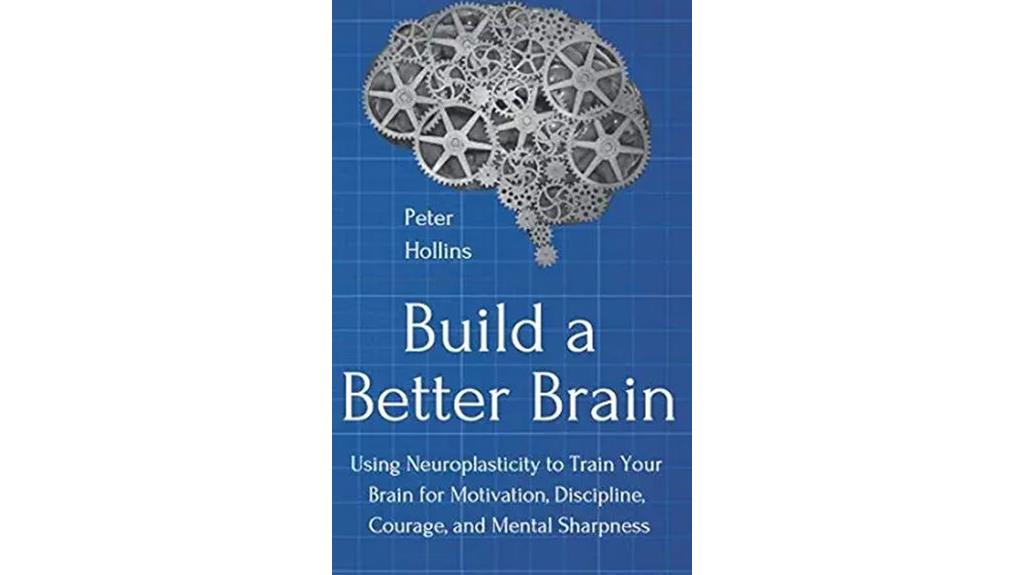
The “Build a Better Brain” book on neuroplasticity and mental skills is ideal for anyone enthusiastic to understand how their brain functions and take control of their mental habits. I love how it explains that our brains are wired in ways that often lead to automatic, unhelpful behaviors, but that neuroplasticity offers a way to rewire these patterns. The book shares practical techniques for strengthening desired habits, controlling impulses, and overcoming fears without needing scientific expertise. It’s empowering, showing that by understanding neural growth, I can improve motivation, confidence, and resilience—ultimately shaping my mind for success and happiness.
Best For: individuals eager to understand and harness neuroplasticity to improve mental habits, motivation, and confidence without requiring scientific expertise.
Pros:
- Provides practical, easy-to-implement techniques for brain rewiring and habit formation
- Empowers readers to take control of their thoughts, impulses, and fears for personal growth
- Combines accessible neuroscience insights with actionable strategies for mental improvement
Cons:
- May oversimplify complex scientific concepts for some readers seeking in-depth technical detail
- Focuses primarily on self-help applications, possibly lacking advanced neuroscience depth
- Requires consistent effort and practice to see significant long-term results
Retrain Your Brain Workbook for CBT in 7 Weeks

Retrain Your Brain Workbook for CBT in 7 Weeks stands out as an ideal choice for individuals seeking a structured, practical approach to managing depression and anxiety. Developed by psychologist Dr. Seth Gillihan, this book offers a clear, step-by-step plan grounded in proven cognitive behavioral techniques. Over seven weeks, I guide you through exercises like goal-setting, facing fears, and replacing negative thoughts. The activities are straightforward and easy to incorporate into daily life, making it accessible for beginners. This workbook empowers you to take control of your mental health, fostering lasting habits that promote emotional resilience and well-being.
Best For: individuals seeking a structured, practical, and accessible approach to managing depression and anxiety through proven CBT techniques.
Pros:
- Provides a clear, step-by-step 7-week plan developed by an experienced psychologist.
- Features straightforward, relatable activities that are easy to incorporate into daily life.
- Empowers users to develop lasting, positive mental health habits and resilience.
Cons:
- May require commitment over the full 7-week period to see significant results.
- As a workbook, it relies on self-motivation and consistent effort for effectiveness.
- Might be less suitable for individuals seeking intensive or personalized therapy options.
The Brain That Changes Itself Book

For anyone enthusiastic to liberate their brain’s full potential, Norman Doidge’s *The Brain That Changes Itself* offers compelling insights into neuroplasticity. I was fascinated to learn how the brain isn’t fixed but can reorganize itself throughout life. Doidge introduces pioneering scientists whose research proves that brain rewiring can help stroke survivors regain speech and even enable someone born with half a brain to function normally. These stories highlight the brain’s extraordinary adaptability and challenge old beliefs about fixed intelligence and ability. This book changed how I see human potential, showing that with effort and the right techniques, we can reshape our brains at any age.
Best For: individuals interested in understanding how the brain can change and improve through neuroplasticity, as well as those seeking personal growth, recovery from neurological challenges, or new learning strategies.
Pros:
- Provides compelling real-life stories demonstrating brain adaptability and potential for change.
- Offers groundbreaking scientific insights that challenge traditional views of fixed brain functions.
- Inspires hope and motivation for personal development and overcoming neurological obstacles.
Cons:
- Some readers may find the scientific content complex or technical.
- The book’s focus on case studies might not appeal to those seeking purely theoretical or clinical information.
- As a popular science book, it may lack detailed scientific methodology for strict academic use.
Neuroplasticity (The MIT Press Essential Knowledge series)

If you’re looking to harness the brain’s ability to change and improve at any age, understanding neuroplasticity is essential. Fifty years ago, scientists believed mature brains were fixed like amber, unable to change. Now, we understand the brain and nervous system continuously adapt throughout life, thanks to neuroplasticity. This shift reveals that our brains aren’t static; they’re dynamic, capable of forming new connections via learning, experience, and even recovery from injury. From synaptic pruning during development to adult neurogenesis, these processes shape our cognition and behavior. Recognizing this ongoing plasticity empowers us to adopt habits that foster lifelong mental growth and resilience.
Best For: individuals interested in understanding how lifelong learning, recovery, and personal growth are supported by the brain’s capacity for neuroplasticity.
Pros:
- Highlights the brain’s ability to adapt and change throughout life, encouraging continuous growth.
- Provides insights into effective ways to harness neuroplasticity through learning and experience.
- Emphasizes the importance of mental activities, rehabilitation, and healthy habits for cognitive resilience.
Cons:
- May oversimplify complex neurobiological processes for a general audience.
- Lacks detailed practical strategies for applying neuroplasticity principles in daily life.
- Does not address potential limitations or individual differences in neuroplastic capacity.
The Stress-Proof Brain: Master Your Emotional Response to Stress

Anyone looking to strengthen their emotional resilience in today’s hectic world will find the Stress-Proof Brain approach invaluable. Modern stress is unavoidable, but how we respond shapes our well-being. By harnessing neuroplasticity, I’ve learned to rewire my brain for better stress management. This involves replacing unhealthy reactions like avoidance, negative thinking, and self-criticism with healthier strategies rooted in mindfulness, neuroscience, and positive psychology. Through targeted exercises, I’ve developed a personalized toolkit that helps me stay calm and resilient, even in challenging situations. Mastering my emotional responses has improved my mental health, happiness, and ability to face life’s stressors with confidence.
Best For: individuals seeking to build emotional resilience and better manage stress in a busy, modern world through neuroscience-based techniques.
Pros:
- Combines mindfulness, neuroscience, and positive psychology for a comprehensive approach
- Provides practical exercises to rewire emotional responses and develop resilience
- Helps improve mental health, happiness, and confidence in facing stressors
Cons:
- Requires commitment to practicing exercises regularly for best results
- May involve a learning curve for those unfamiliar with neuroscience or mindfulness concepts
- Does not eliminate stressors but focuses on changing responses, which may not suit everyone’s needs
Your Brain on Ink Workbook on Neuroplasticity and Journal Ladder
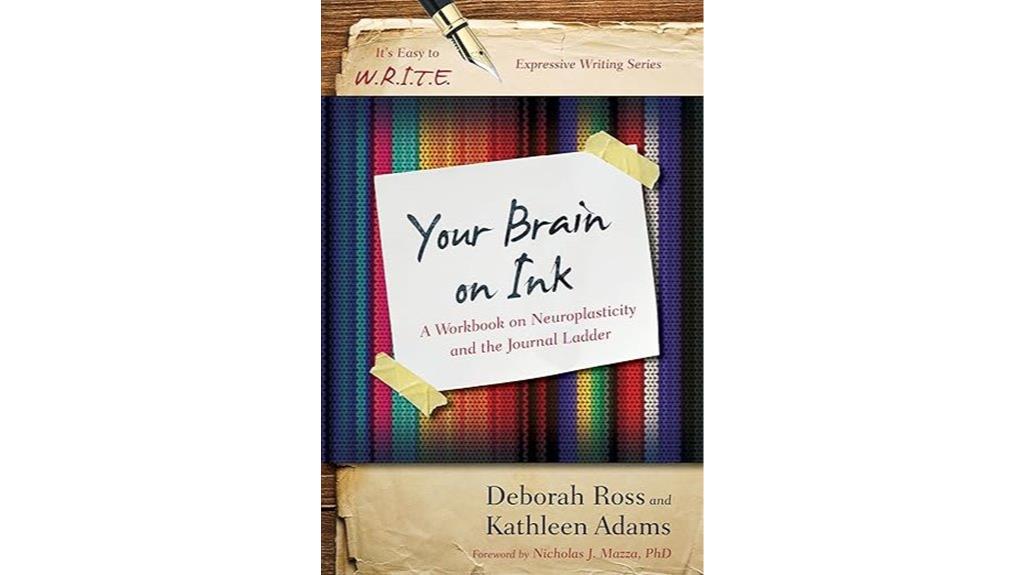
The Your Brain on Ink Workbook on Neuroplasticity and Journal Ladder stands out as an ideal resource for individuals enthusiastic to harness the power of their mind through intentional mental activity. This workbook leverages recent neuroscience findings, emphasizing how focused attention can rewire neural pathways for better mental health, resilience, and skills. With over 65 writing prompts and a strengths-based approach, it encourages self-awareness and emotional growth. The included facilitator’s guide makes it easy to lead group sessions, fostering community and shared progress. Overall, this resource empowers you to actively shape your brain’s plasticity, creating lasting positive changes through simple, accessible tools.
Best For: individuals interested in using neuroscience-based techniques to enhance mental health, resilience, and emotional growth through structured journaling and group facilitation.
Pros:
- Offers over 65 targeted writing prompts to promote neuroplasticity and self-awareness
- Includes a comprehensive facilitator’s guide for effective group sessions of various durations
- Emphasizes a strengths-based, positive approach rooted in current neuroscience research
Cons:
- May require a facilitator or group setting to maximize its community benefits
- Some users might find the workbook’s structured prompts limiting for free-form writing
- The depth of neuroscience content may be too advanced for complete beginners without prior background
Create a Better Brain through Neuroplasticity: A Manual for Mamas
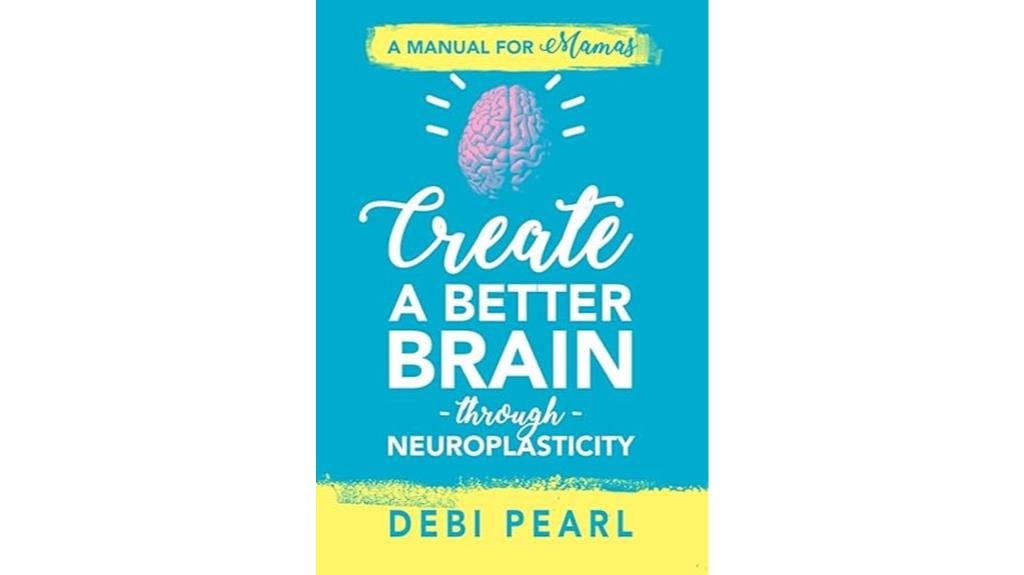
Mamas seeking to nurture their children’s brains will find this manual an invaluable resource for harnessing neuroplasticity. It shows how simple, practical activities like music and exercise can markedly boost brain growth, especially for kids with ADHD, Autism, or brain injuries. By understanding what promotes healthy neuroplasticity—and what harms it—we can create a supportive environment that fosters confidence, happiness, and motivation. This manual combines current scientific research with real-life stories, giving you clear, actionable steps to help your children develop stronger, more adaptable brains. It’s a powerful guide to transforming lives, starting with your child’s brain today.
Best For: Mamas who want to actively support their children’s brain development, especially those with ADHD, Autism, or brain injuries, using practical, research-based strategies.
Pros:
- Provides evidence-based activities like music and exercise to promote neuroplasticity.
- Combines current scientific research with real-life success stories for practical guidance.
- Focuses on fostering confidence, happiness, and motivation in children through simple steps.
Cons:
- May require consistent effort and time commitment from busy caregivers.
- Some activities might need additional resources or equipment.
- The manual may not cover every individual child’s unique developmental needs.
The SharpBrains Guide to Brain Fitness

If you’re looking for a science-backed resource to enhance your understanding of brain health, The SharpBrains Guide to Brain Fitness stands out as a top choice. It emphasizes the importance of maintaining cognitive resilience amid modern challenges like longer lifespans and rapid change. The book offers evidence-based strategies rooted in recent research, debunking myths and marketing hype. It provides practical, personalized tips to improve memory, focus, and prevent decline. Recognized by AARP and praised for its clarity and scientific rigor, it’s an essential guide for anyone *enthusiastic* to make informed decisions and actively boost their brain health throughout life.
Best For: individuals seeking a scientifically grounded, practical guide to understanding and improving their brain health throughout life.
Pros:
- Offers evidence-based strategies rooted in recent neuroscience research.
- Provides clear, personalized tips for enhancing memory, focus, and cognitive resilience.
- Recognized and endorsed by reputable organizations like AARP for its scientific rigor and accessibility.
Cons:
- May require a proactive mindset to implement lifestyle changes suggested.
- As a general guide, it might not address highly specific or clinical neurological conditions.
- Some readers might find the scientific content dense without supplementary background knowledge.
Keep Sharp: Build a Better Brain at Any Age
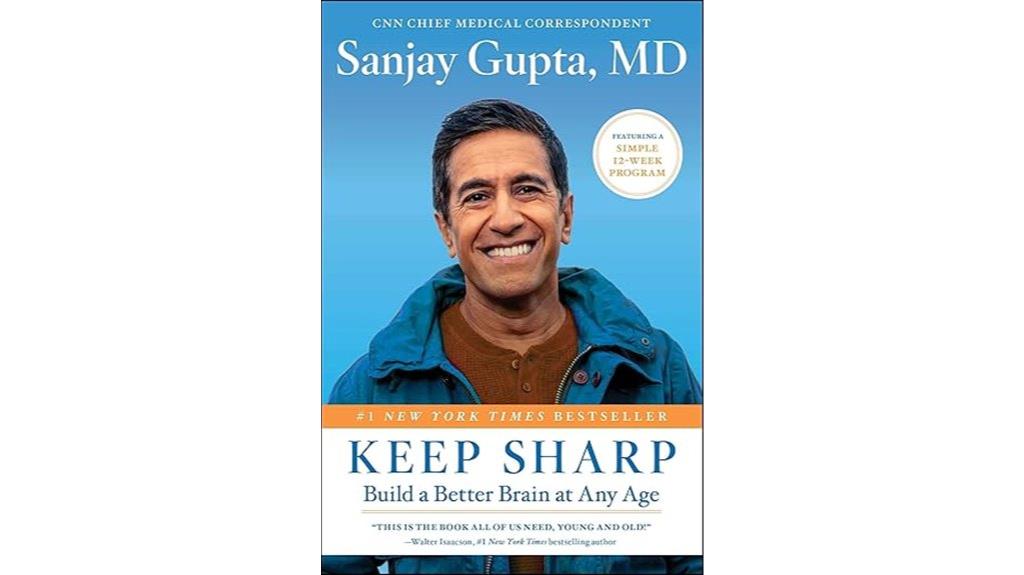
Anyone looking to maintain their mental sharpness at any age will find Dr. Sanjay Gupta’s *Keep Sharp* invaluable. This science-based guide debunks myths about aging and cognitive decline, emphasizing that we can actively support brain health through lifestyle choices. Gupta explores activities like socializing versus brain-training games, highlighting what truly benefits cognition. He also examines exceptional older individuals to uncover habits that preserve mental agility. With practical strategies and a personalized twelve-week program, *Keep Sharp* empowers me—and anyone—to build a stronger, healthier brain throughout life. It’s a compelling reminder that age is no barrier to mental vitality.
Best For: individuals of any age seeking to actively maintain and improve their cognitive health through science-based strategies and lifestyle changes.
Pros:
- Provides a comprehensive, science-driven approach to brain health.
- Offers practical, easy-to-implement daily strategies and a personalized twelve-week program.
- Debunks common myths about aging and cognitive decline, empowering readers with accurate information.
Cons:
- May require consistent effort and lifestyle adjustments to see significant benefits.
- Some readers might find the focus on supplements and drugs less conclusive or balanced.
- The book primarily covers general strategies, which may not address specific medical conditions or individual needs.
Neuroplasticity Explained
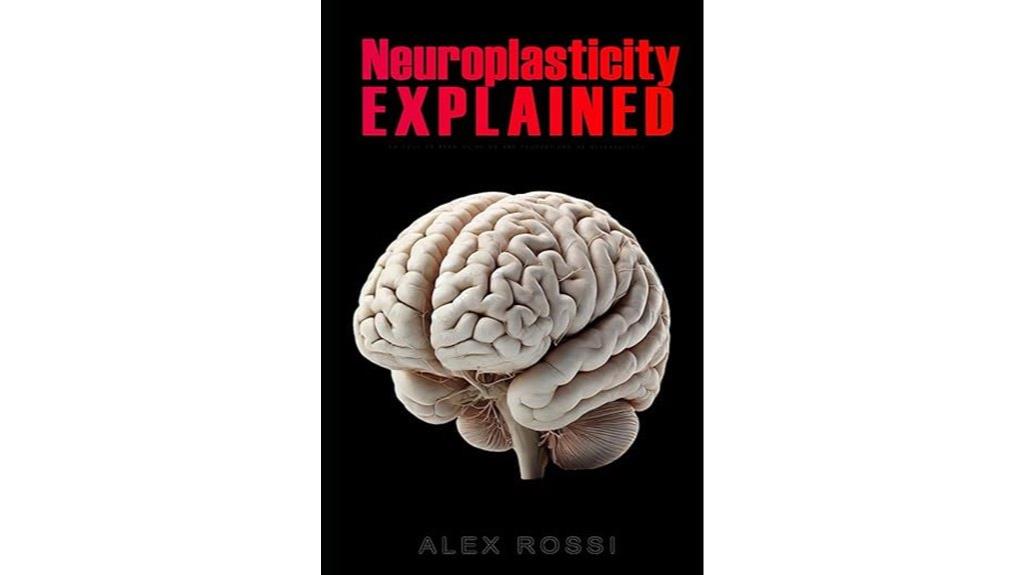
Neuroplasticity is the brain’s remarkable ability to reorganize itself by forming new connections and pathways, even into adulthood. I find it fascinating that our brains aren’t fixed, but constantly adapting through learning, experience, and recovery from injury. This process involves cellular changes like synaptic modifications and neurogenesis, which enable us to learn new skills, remember information, and heal after damage. Research has shown that neuroplasticity is active throughout our lives, though it may decline with age. By understanding these mechanisms, we can harness our brain’s natural capacity for growth, making neuroplasticity a powerful tool for personal development and rehabilitation.
Best For: individuals interested in understanding how the brain adapts and recovering from injury, as well as those seeking to enhance personal growth through neuroplasticity.
Pros:
- Provides accessible explanations suitable for both beginners and experts.
- Highlights practical applications in learning, memory, and rehabilitation.
- Emphasizes the ongoing potential for brain growth and recovery across the lifespan.
Cons:
- May oversimplify complex biological mechanisms for a general audience.
- Could benefit from more detailed discussion on specific therapeutic technologies.
- Might not cover the latest cutting-edge research developments in neuroplasticity.
Neuroplasticity Made Easy Book

The “Neuroplasticity Made Easy Book” stands out as an ideal resource for beginners and those seeking a straightforward introduction to harnessing brain plasticity. I found it accessible, breaking down complex concepts into simple, actionable insights. It covers how neuroplasticity shapes learning, memory, and recovery, emphasizing that our brains are constantly rewiring. The book highlights practical strategies like mental exercises, physical activity, and mindfulness that anyone can apply to boost their brain health. It also explores the science behind neuroplasticity’s evolution and real-life success stories, making it clear that positive change is possible at any age. This book is a great starting point for anyone enthusiastic to understand and leverage their brain’s potential.
Best For: beginners and anyone interested in understanding and applying neuroplasticity to improve brain health and personal growth.
Pros:
- Simplifies complex neuroplasticity concepts into easy-to-understand insights.
- Offers practical strategies like mental exercises, physical activity, and mindfulness.
- Features real-life success stories and scientific background to motivate and inform.
Cons:
- May lack in-depth technical or advanced neuroscientific details for experts.
- Focuses primarily on general applications, possibly overlooking specific clinical therapies.
- Some readers might find the breadth of topics introductory and want more comprehensive coverage.
Brain Training Neuroplasticity Neuroscience In Progress Throw Pillow

If you’re passionate about mental health, neuroscience, or personal growth, the Brain Training Neuroplasticity Neuroscience In Progress Throw Pillow makes a perfect statement piece. Its vibrant multicolor design celebrates the brain’s incredible ability to adapt, grow, and rewire itself. Made from soft, double-sided printed polyester, it’s ideal for sparking conversations about neuroplasticity and ongoing self-improvement. Measuring 16×16 inches, it’s lightweight and easy to care for with spot cleaning. Whether displayed in your living room or used as a thoughtful gift, this pillow reminds us that our brains are constantly evolving—making it a meaningful addition to any mental health or neuroscience enthusiast’s space.
Best For: mental health advocates, neuroscience enthusiasts, and personal growth seekers looking to celebrate brain plasticity and spark conversations about neurorehiring.
Pros:
- Vibrant multicolor design visually inspiring and attention-grabbing
- Made from soft, durable 100% polyester fabric, suitable for everyday use
- Double-sided print enhances aesthetic appeal and message visibility
Cons:
- Spot cleaning or dry cleaning required; not machine washable
- Limited warranty details; support depends on manufacturer policies
- Available only in 16×16 inch size, which may not suit all decor preferences
Brain Training Neuroplasticity Neuroscience In Progress Throw Pillow
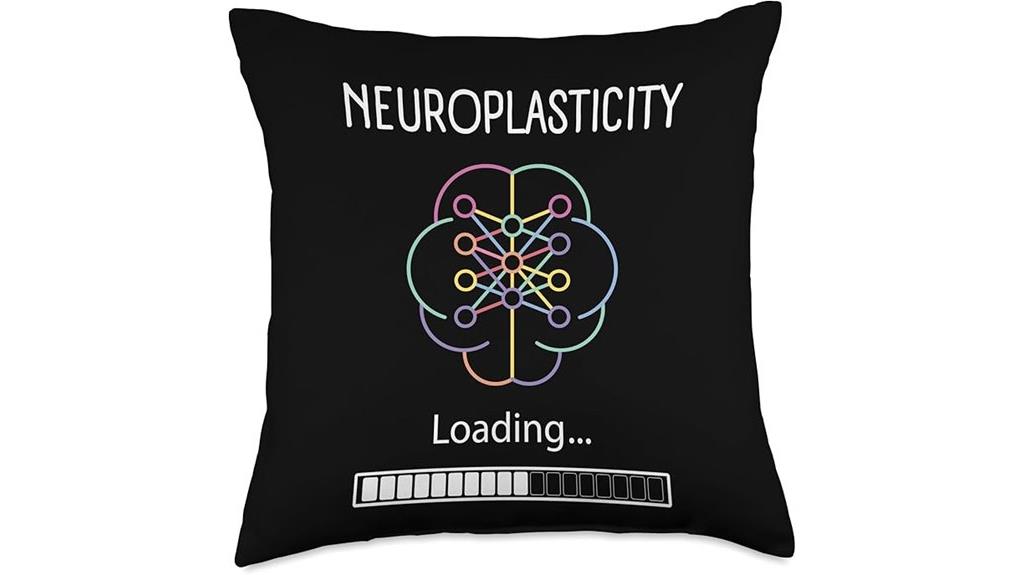
This throw pillow is an ideal choice for anyone passionate about understanding and celebrating brain adaptability. Its creative loading design symbolizes neuroplasticity, growth, and reshaping, making it perfect for mental health enthusiasts, neuroscience lovers, or personal growth advocates. Crafted from durable 100% polyester fabric with vibrant double-sided prints, it’s built to spark conversations about brain rewiring and ongoing development. Measuring 18×18 inches, it’s suitable for personal spaces, offices, or as a thoughtful gift. Filled with polyester and sewn by hand, this pillow serves as a visual reminder that our brains are continually evolving, encouraging mindfulness and curiosity about neuroplasticity’s incredible potential.
Best For: mental health advocates, neuroscience enthusiasts, and individuals interested in personal growth and brain development.
Pros:
- Vibrant double-sided print enhances visual appeal and conversation starters.
- Made from durable, high-quality polyester fabric suitable for everyday use.
- Serves as an inspiring reminder of neuroplasticity and ongoing brain development.
Cons:
- Spot clean or dry clean only, requiring careful maintenance.
- Handmade sewing may result in slight variations in craftsmanship.
- Limited size options (18×18 inches) may not suit all decor preferences.
Soft-Wired: How the New Science of Brain Plasticity Can Change Your Life

For anyone enthusiastic to unleash their brain’s full potential, *Soft-Wired* offers scientifically backed strategies to harness neuroplasticity and reshape mental habits. Dr. Michael Merzenich explains how our brains constantly rewire based on experiences, allowing lifelong learning and adaptation. The book highlights how personal memories, skills, and quirks are shaped by unique neural connections influenced by environment. It provides practical, proven methods to rejuvenate and remodel the brain, improving cognitive function and emotional health. By understanding these principles, you can target specific areas for growth, making positive changes at any age. *Soft-Wired* empowers you to unlock your brain’s remarkable capacity for change.
Best For: individuals seeking scientifically backed strategies to enhance brain function, emotional resilience, and lifelong learning through neuroplasticity.
Pros:
- Provides clear, evidence-based methods for brain rejuvenation and remodeling
- Emphasizes the potential for personal growth at any age
- Offers practical guidance and self-assessment tools to optimize brain health
Cons:
- May require consistent effort and practice to see noticeable results
- Some techniques may need adaptation for specific individual needs
- The scientific content might be complex for readers without a background in neuroscience
Factors to Consider When Choosing Neuroplasticity Brain-Training

When selecting a neuroplasticity training program, I consider factors like scientific validity, my personal goals, and whether the activities are age-appropriate. I also look at the types of exercises offered and how easy the platform is to use. These points help me find a program that’s effective and fits my lifestyle.
Scientific Validity
Evaluating the scientific validity of neuroplasticity brain-training programs is essential to guarantee they actually produce meaningful changes in the brain. I look for programs rooted in peer-reviewed research that demonstrate clear neuroplasticity effects. Evidence from neuroimaging studies is vital, showing measurable changes in neural pathways or brain activity after training. I also prioritize programs with randomized controlled trials that compare outcomes against control groups, confirming their efficacy. A solid scientific foundation based on established neuroscience principles, like synaptic strengthening and neurogenesis, adds credibility. Finally, I check whether claims are supported by replicable data and peer-reviewed publications. This ensures the program’s effectiveness isn’t just hype but backed by reliable, scientific evidence.
Personal Goals
Choosing the right neuroplasticity brain-training program starts with a clear understanding of your personal goals. Think about what you want to achieve—whether it’s enhancing memory, reducing stress, or improving focus. Knowing your goals helps you select targeted exercises that address specific needs. Determine if your goals require cognitive, emotional, or behavioral changes to choose the most effective techniques. For example, strengthening emotional regulation calls for different approaches than boosting executive function. It’s also important to match your goals with evidence-based practices proven to work for similar objectives. Finally, assess your current lifestyle and commitment level to pick exercises you can sustain consistently. Clear goals ensure your training aligns with your personal development aims and maximizes results.
Age Appropriateness
Since our brains change differently at each stage of life, selecting a neuroplasticity brain-training program requires considering age-specific factors. For children, activities should be playful, engaging, and tailored to support healthy brain development, emphasizing fun and learning. Adults benefit from more challenging exercises that stimulate cognitive growth while fitting into busy schedules. For seniors, programs should focus on gentle, gradual exercises that accommodate potential cognitive and physical limitations, ensuring safety and effectiveness. While neuroplasticity decreases with age, it remains significant throughout our lives, so choosing age-appropriate activities helps maximize results and safety. Tailoring programs to your age ensures that the methods are aligned with your brain’s current neuroplastic potential, making your training more effective and sustainable.
Activity Types
Selecting the right activity types for neuroplasticity training involves understanding how different exercises target various brain functions. Physical activities boost motor skills and coordination, while mental puzzles enhance problem-solving and memory. Mindfulness practices improve emotional regulation and focus. Engaging in novel, challenging tasks encourages synaptic growth and strengthens neural pathways. Multisensory activities that stimulate multiple brain regions simultaneously can accelerate neural rewiring, making your training more effective. Activities that involve active learning and skill development tend to lead to more lasting brain changes. Combining physical, cognitive, and emotional exercises creates a holistic approach, addressing different neural networks and optimizing overall neuroplasticity. Choosing varied activity types that challenge and engage you is key to maximizing brain adaptability and growth.
Ease of Use
When evaluating neuroplasticity brain-training programs, ease of use plays a key role in maintaining consistent practice. I look for programs with simple instructions that fit seamlessly into my daily routine, making it easier to stay committed. User-friendly interfaces and clear visual cues also matter, especially since they help me navigate activities quickly, regardless of my age or tech skills. Programs that require minimal equipment or technology reduce obstacles, encouraging me to stick with them longer. Step-by-step guidance and straightforward exercises make it easier to understand and apply mental training right away. Overall, a simple, intuitive design boosts my motivation and confidence, helping me stay engaged and consistent in my brain-training journey.
Duration Commitment
Choosing the right duration for neuroplasticity training depends on your goals and commitment level. Longer programs, like 8-12 weeks, typically lead to more lasting neural changes, especially when you train consistently. Daily or near-daily sessions boost the brain’s ability to form new pathways through repetition and reinforcement. While shorter programs might offer temporary improvements, sustained effort over several months is usually needed for deep, lasting change. The ideal duration varies based on individual goals; complex skill development or recovery often requires extended practice. Remember, regular, incremental training is more effective for neuroplastic adaptation than sporadic sessions. Committing to a consistent routine over time maximizes the benefits and helps guarantee meaningful, enduring improvements in brain function.
Progress Tracking
Effective progress tracking plays a pivotal role in optimizing your neuroplasticity brain-training efforts. I recommend measuring changes in key cognitive functions like memory, attention, and processing speed over time. Using objective assessments, such as neuropsychological tests or computerized tasks, gives you clear, quantifiable data on your improvements. Complement these with regular notes on subjective experiences, like mental clarity or emotional resilience, to get a full picture of your progress. Visual tools like charts or journals can help you stay motivated and spot patterns or plateaus in your development. Consistent documentation and review enable you to make informed adjustments to your routines, ensuring you maximize neuroplasticity benefits. Tracking your progress effectively keeps your training focused and results-driven.
Expert Endorsements
Expert endorsements play a essential role in helping you identify reliable neuroplasticity brain-training programs. They lend credibility by highlighting scientific validation and clinical effectiveness. When leading neuroscientists and clinicians endorse a program, it signals that the techniques are based on current research and align with the latest scientific understanding. These endorsements also show that the methods are safe and backed by empirical evidence, which is fundamental when choosing a brain-training program. Reputable experts emphasize the importance of evidence-based practices, guiding you toward options with strong scientific support. Trustworthy endorsements help you distinguish high-quality programs from less credible or unproven methods, giving you confidence that you’re investing in effective training that genuinely boosts your brain power.
Frequently Asked Questions
Can Neuroplasticity Programs Improve Age-Related Cognitive Decline Effectively?
Yes, neuroplasticity programs can effectively improve age-related cognitive decline. I’ve seen firsthand how targeted brain exercises stimulate neural connections, enhancing memory, focus, and problem-solving skills in older adults. These programs encourage the brain to adapt and rewire itself, counteracting some effects of aging. I recommend engaging consistently with these exercises—it’s a practical way to maintain mental sharpness and boost overall cognitive health as you age.
How Long Does It Typically Take to Notice Results From Brain-Training Programs?
Results from brain-training programs can appear like dawn breaking—it varies, but I usually notice improvements within 4 to 6 weeks. Consistency is key, and just like planting a seed, patience helps it grow. Some people see quick changes, while others need more time. Keep at it, and you’ll likely start noticing sharper focus, better memory, or quicker thinking as your brain rewires itself over time.
Are There Any Risks Associated With Intensive Neuroplasticity Exercises?
Yes, there are some risks with intensive neuroplasticity exercises. I’ve found that overdoing it can cause mental fatigue, headaches, or frustration. Sometimes, pushing too hard might lead to stress or burnout, which can hinder progress. That’s why I always recommend starting slow, listening to your body, and consulting a professional if you experience persistent discomfort. Balance and moderation are key to safely boosting your brain power.
Which Neuroplasticity Techniques Are Most Suitable for Children Versus Adults?
Think of the brain like a garden—kids’ brains are like wildflowers, eager and adaptable, so playful, engaging activities work best. For adults, it’s more like pruning and nurturing, so techniques like mindfulness and targeted memory exercises are more suitable. I’ve seen children thrive with imaginative play, while adults benefit from structured brain-training apps. Adapting the approach to age guarantees the most effective neuroplasticity growth.
How Do I Choose the Best Brain-Training Program for My Specific Needs?
To choose the best brain-training program for my needs, I first identify my goals—whether improving memory, focus, or mental agility. I look for programs backed by scientific research and user reviews. I also consider my schedule and preferred learning style. I test a few options, paying attention to how they challenge me and fit into my routine. Ultimately, I select the one that feels engaging and shows measurable progress.
Conclusion
So, there you have it—15 brain-training programs to turn your noggin into a supercomputer by 2025. Because, let’s face it, who doesn’t want a brain so plastic it can bend over backwards without breaking a sweat? Just pick a book, do the work, and pretend you’re not secretly hoping for a miracle. After all, with enough neuroplasticity, maybe you’ll finally remember where you left your keys—and your sense of humor.
